Region Western philosophy | Other names "Dionysius", "Denys" | |
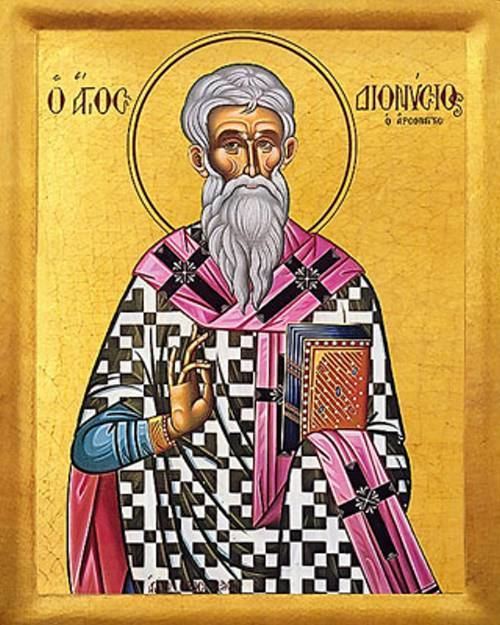 | ||
Died unknown(5th–6th century AD) Influenced Books De Coelesti Hierarchia, Divine Names, The Collected Works of, The Works of Dionysius, The Mystical Theology Similar | ||
Pseudo-Dionysius the Areopagite (Greek: Διονύσιος ὁ Ἀρεοπαγίτης), also known as Pseudo-Denys, was a Christian theologian and philosopher of the late 5th to early 6th century (writing before 532), probably Syrian, the author of the set of works commonly referred to as the Corpus Areopagiticum or Corpus Dionysiacum. The author pseudonymously identifies himself in the corpus as "Dionysios", portraying himself as the figure of Dionysius the Areopagite, the Athenian convert of Paul of Tarsus mentioned in Acts 17:34. This false attribution to the earliest decades of Christianity resulted in the work being given great authority in subsequent theological writing in both East and West, with its influence only decreasing in the West with the 15th century demonstration of its later dating.
Contents
- Pseudo dionysius the areopagite
- Dating
- Thought
- Eastern adoption
- Western medieval Dionysian tradition
- Astronomical fresco
- Authorship
- Modern appraisal
- References
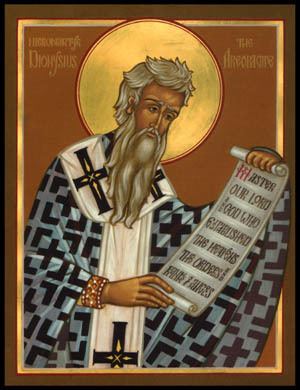
In recent decades, interest has increased again in the Corpus Areopagiticum for three main reasons: because of a recovery of the huge impact of Dionysian thought in later Christian thought, because of an increasing repudiation of older criticisms that Dionysius's thought represented a fundamentally Neoplatonic approach to theology, and finally because of interest in parallels between aspects of modern linguistic theory and Dionysius's reflections on language and negative theology.
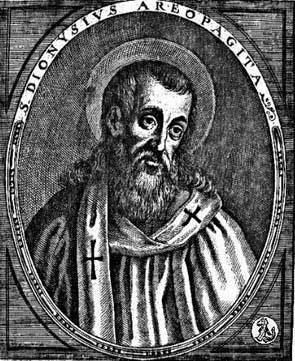
Pseudo dionysius the areopagite
Dating
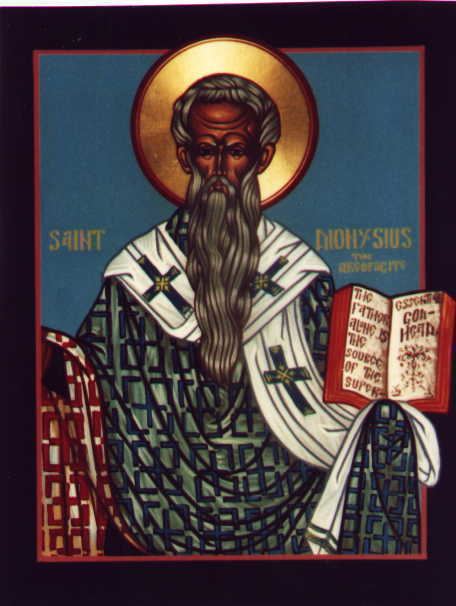
In attempts to identify a date after which the corpus must have been composed, a number of features have been identified in Dionysius' writing, though the latter two are subject to scholarly debate.
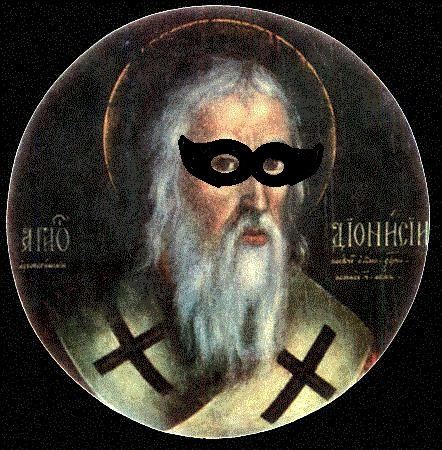
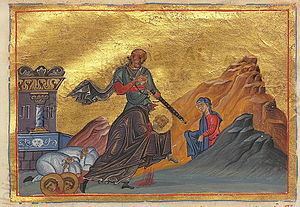
In terms of the latest date for the composition of the Corpus, the earliest datable reference to Dionysius' writing comes in 528, the year in which the treatise of Severus of Antioch entitled Adversus apologiam Juliani was translated into Syriac — though it is possible the treatise may originally have been composed up to nine years earlier.
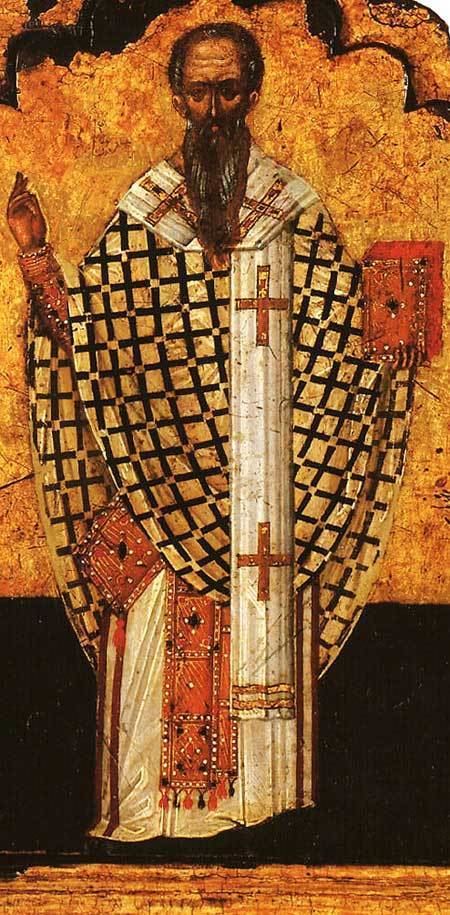
Another widely cited latest date for Dionysius' writing comes in 532, when, in a report on a colloquy held between two groups (orthodox and monophysite) debating the decrees of the Council of Chalcedon, Severus of Antioch and his monophysite supporters cited Dionysius' Fourth Letter in defence of their view. It is possible that pseudo-Dionysius was himself a member of this group, though debate continues over whether his writings do in fact reveal a monophysite understanding of Christ. It seems likely that the writer was located in Syria, as revealed, for example, by the accounts of the sacramental rites he gives in The Ecclesiastical Hierarchy, which seem only to bear resemblance to Syriac rites.
Thought
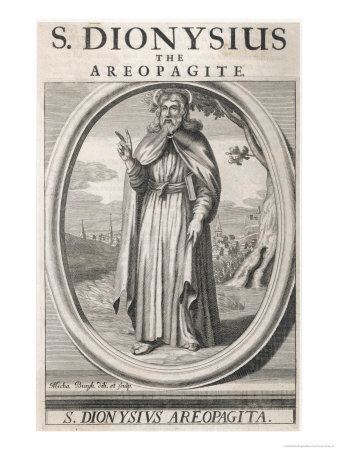
The Corpus is today composed of Divine Names (Περὶ θείων ὀνομάτων), Mystical Theology (Περὶ μυστικῆς θεολογίας), Celestial Hierarchy (Περὶ τῆς οὐρανίου ἱεραρχίας), Ecclesiastical Hierarchy (Περὶ τῆς ἐκκλησιαστικῆς ἱεραρχίας), and ten epistles. Seven other works, namely Theological Outlines (Θεολογικαὶ ὑποτυπώσεις), Symbolic Theology (Συμβολικὴ θεολογία), On Angelic Properties and Orders (Περὶ ἀγγελικῶν ἰδιοτήτων καὶ τάξεων), On the Just and Divine Judgement (Περὶ δικαίου καὶ θείου δικαστηρίου), On the Soul (Περὶ ψυχῆς), On Intelligible and Sensible Beings, and On the Divine Hymns, are mentioned repeatedly by pseudo-Dionysius in his surviving works, and are presumed either to be lost or to be fictional works mentioned by the Areopagite as a literary device to give the impression to his sixth century readers of engaging with the surviving fragments of a much larger first century corpus of writings.
His works are mystical and show strong Neoplatonic influence. For example he uses Plotinus' well-known analogy of a sculptor cutting away that which does not enhance the desired image, and shows familiarity with Proclus. He also shows influence from Clement of Alexandria, the Cappadocian Fathers, Origen of Alexandria, Parmenides and others.
There is a distinct difference between pagan Neoplatonism and that of Eastern Christianity. In the former all life returns to the source to be stripped of individual identity, a process called henosis, while in orthodox Christianity the Likeness of God in man is restored by grace (by being united to God the Holy Trinity through participation in His divine energies), a process called theosis.
Eastern adoption
His thought was initially used by monophysites to back up parts of their arguments but his writings were eventually adopted by other church theologians, primarily due to the work of John of Scythopolis and Maximus the Confessor in producing an orthodox interpretation. Writing a single generation at most after Dionysius, perhaps between 537 and 543, John of Scythopolis composed an extensive set (around 600) of scholia (that is, marginal annotations) to the works of Dionysius; these were in turn prefaced by a long prologue in which John set out his reasons for commenting on the corpus. All Greek manuscripts of the Corpus Areopagiticum surviving today stem from an early sixth-century manuscript containing John's Scholia and Prologue — so John of Scythopolis had an enormous influence on how Dionysius was read in the Greek-speaking world.
Theologians such as John of Damascus and Germanus of Constantinople also made ample use of Dionysius' writing.
The Dionysian writings and their mystical teaching were universally accepted throughout the East, amongst both Chalcedonians and non-Chalcedonians. St. Gregory Palamas, for example, in referring to these writings, calls the author, "an unerring beholder of divine things".
The Corpus is also present in Syriac and Armenian versions, the former of which, by Sergius of Reshaina in the early sixth century, serves as a terminus ante quem for the dating of the original Greek.
Western medieval Dionysian tradition
The first notice of Dionysius in the West comes from Gregory the Great, who probably brought a codex of the Corpus Areopagitum back with him on his return from his mission as papal legate to the Emperor in Constantinople in around 585. Gregory refers occasionally in his writings to Dionysius, although Gregory's Greek was probably not good enough to fully engage with Dionysius's work. In the seventh and eighth centuries, Dionysius was not widely known in the West, aside from a few scattered references.
The real influence of Dionysius in the West, however, began with the gift in 827 of a Greek copy of his works by the Byzantine Emperor Michael II to the Carolingian King Louis the Pious, who in turn gave the manuscript to the monastery of St Denys near Paris where, in about 838, Dionysius' works were translated into Latin for the first time by Hilduin, abbot of the monastery. It may well have been Hilduin himself who promoted his work (and his abbey) by developing the legend (which would be widely accepted during subsequent centuries), that Saint Denis of Paris was the same person as Saint Dionysius the Areopagite of Acts 17.34, and that Saint Dionysius the Areopagite had traveled to Rome and then was commissioned by the Pope to preach in Gaul (France), where he was martyred. Hilduin's translation, however, is almost unintelligible.
About twenty years later, a subsequent Carolingian Emperor, Charles the Bald, requested the Irishman John Scottus Eriugena to make a fresh translation; he finished this in 862. However, this translation itself did not widely circulate in subsequent centuries. Moreover, although Eriugena’s own works, such as the Homily on the Prologue of St John, show the influence of Dionysian ideas, these works were not widely copied or read in subsequent centuries. The Benedictine monasticism that formed the standard monasticism of the eighth to eleventh centuries, therefore, in general paid little attention to Dionysius.
In the twelfth century, greater use gradually began to be made of Dionysius among various traditions of thought:
During the thirteenth century, the Franciscan Robert Grosseteste made an important contribution by bringing out between 1240 and 1243 a translation, with commentary, of the Dionysian corpus. Soon after, the Dominican Albert the Great did likewise. The thirteenth-century Parisian corpus provided an important reference point by combining the "Old Translation" of Eriugena with the "New Translation" of John Sarrazin, along with glosses and scholia by Maximus the Confessor, John of Scythopolis and others, as well as the "Extracts" by Thomas Gallus, and several commentaries such as John the Scot, John Sarrazin and Hugh of St Victor on The Celestial Hierarchy. It quickly became common to make reference to Dionysius. Thomas Aquinas wrote an explanation for several works, and cites him over 1700 times. Bonaventure called him the “prince of mystics”.
It was subsequently in the area of mysticism that Dionysius, especially his portrayal of the "via negativa" , was particularly influential. In the fourteenth and fifteenth centuries his fundamental themes were hugely influential on thinkers such as Marguerite Porete, Meister Eckhart, John Tauler, Jan van Ruusbroec, the author of The Cloud of Unknowing (who made an expanded Middle English translation of Dionysius' Mystical Theology), Jean Gerson, Nicholas of Cusa, Denys the Carthusian, Julian of Norwich and Harphius Herp. His influence can also be traced in the Spanish Carmelite thought of the sixteenth century among Teresa of Avila and John of the Cross.
Astronomical fresco
In a letter addressed to Polycarp, pseudo-Dionysius asks "What have you to say about the solar eclipse which occurred when the Savior was put on the Cross? At the time the two of us were in Heliopolis and we both witnessed the extraordinary phenomenon of the moon hiding the sun at the time that was out of season for their coming together.... We saw the moon begin to hide the sun from the east, travel across to the other side of the sun, and return on its path so that the hiding and the restoration of the light did not take place in the same direction but rather in diametrically opposite directions...."
In reality, an eclipse (of the sun by the moon) could not have happened at the time of Christ's crucifixion since Passover (when the Gospels state the Crucifixion took place) is a full moon event, and solar eclipses always happen at new moon. It seems probable that pseudo-Dionysius had read the Alexandrinus variant of Gospel of Luke (Luke 23:44-45) where the darkness said to have accompanied the Crucifixion is attributed to an eclipse, and that this influenced his writing.
The passage gave rise to a medieval legend about an eclipse taking place at the Crucifixion. This is illustrated in an astronomical fresco in the main gallery of the Escorial Library, near Madrid, Spain, built in 1567-84, which shows Dionysius the Areopagite observing an eclipse at the time of Christ's crucifixion.
Only in the late medieval period did the scientific incoherence of the legend become widely acknowledged: in 1457, for instance, the Italian humanist Lorenzo Valla wrote: "...the claim of 'Dionysius'... that he observed the eclipse of the sun at the hour of the Saviour's death... is as blatant a fiction as the epistolary form of the report."
Authorship
The authorship of the Dionysian Corpus was initially disputed; Severus and his party affirmed its apostolic dating, largely because it seemed to agree with their Christology. However, this dating was disputed by Hypatius of Ephesus, who met the monophysite party during the 532 meeting with Emperor Justinian I; Hypatius denied its authenticity on the grounds that none of the Fathers or Councils ever cited or referred to it. Hypatius condemned it along with the Apollinarian texts, distributed during the Nestorian controversy under the names of Pope Julius and Athanasius, which the monophysites entered as evidence supporting their position.
The first defense of its authenticity is undertaken by John of Scythopolis, whose commentary, the Scholia (ca. 540), on the Dionysian Corpus constitutes the first defense of its apostolic dating, wherein he specifically argues that the work is neither Apollinarian nor a forgery, probably in response both to monophysites and Hypatius—although even he, given his unattributed citations of Plotinus in interpreting Dionysius, might have known better. Dionysius' authenticity is criticized later in the century, and defended by Theodore of Raithu; and by the 7th century, it is taken as demonstrated, affirmed by both Maximus the Confessor and the 649 Lateran Council. From that point until the Renaissance, the authorship was less questioned, though Thomas Aquinas, Peter Abelard and Nicholas of Cusa expressed suspicions about its authenticity; their concerns, however, were generally ignored.
The Florentine humanist Lorenzo Valla (d. 1457), in his 1457 commentaries on the New Testament, did much to establish that the author of the Corpus Areopagiticum could not have been St. Paul's convert, though he was unable to identify the actual historical author. William Grocyn pursued Valla's lines of text criticism, and Valla's critical viewpoint of the authorship of the highly influential Corpus was accepted and publicized by Erasmus from 1504 onward, for which he was criticized by Catholic theologians. In the Leipzig disputation with Martin Luther, 1519, Johann Eck used the Corpus, specifically the Angelic Hierarchy, as argument for the apostolic origin of papal supremacy, pressing the Platonist analogy, "as above, so below".
During the 19th century modernist Catholics too came generally to accept that the author must have lived after the time of Proclus. The author became known as 'Pseudo-Dionysius the Areopagite' only after the philological work of J Stiglmayr and H Koch, whose papers, published independently in 1895, demonstrated the thoroughgoing dependence of the Corpus upon Proclus. Both showed that Dionysius had used, in his treatise on evil in Chapter 4 of The Divine Names, the De malorum subsistentia of Proclus.
Dionysius' identity is still disputed. The compilers of the Stanford Encyclopedia of Philosophy find pseudo-Dionysius to be most probably "a pupil of Proclus, perhaps of Syrian origin, who knew enough of Platonism and the Christian tradition to transform them both. Since Proclus died in 485, and since the first clear citation of Dionysius' works is by Severus of Antioch between 518 and 528, then we can place Dionysius' authorship between 485 and 518-28." Ronald Hathaway provides a table listing most of the major identifications of Dionysius: e.g., Ammonius Saccas, Dionysius the Great, Peter the Fuller, Dionysius the Scholastic, Severus of Antioch, Sergius of Reshaina, unnamed Christian followers of everyone from Origen of Alexandria to Basil of Caesarea, Eutyches to Proclus. In the past half century, Alexander Golitzin, Georgian academician Shalva Nutsubidze and Belgian professor Ernest Honigmann have all proposed identified pseudo-Dionysius the Areopagite with Peter the Iberian. A more recent identification is with Damascius, the last scholarch of the School of Athens. There is therefore no current scholarly consensus on the question of Pseudo-Dionysius' identification.
There was no concept of intellectual property in the ancient world, and plagiarism was widely seen as a homage to the original author. The Stanford Encyclopedia claims "It must also be recognized that 'forgery' is a modern notion. Like Plotinus and the Cappadocian Fathers before him, Dionysius does not claim to be an innovator, but rather a communicator of a tradition." However, while the Pseudo Dionysius can be seen as a communicator of tradition, he can also be seen as a polemicist, who tried to alter Neo-Platonic tradition in a novel way for the Christian world that would make notions of complicated Divine Hierarchies more of an emphasis than notions of direct relationship with the figure of Christ as Mediator.
Modern appraisal
Andrew Louth offers the following modern appraisal of the Areopagite;
Dionysius/Denys' vision is remarkable because, on the one hand, his understanding of hierarchy makes possible a rich symbolic system in terms of which we can understand God and the cosmos and our place within it, and, on the other, he finds room within this strictly hierarchical society for an escape from it, beyond it, by transcending symbols and realizing directly one's relationship with God as his creature, the creature of his love.
There is space within the Dionysian universe for a multitude of ways of responding to God's love. That spaciousness is worth exploring: and therein, perhaps, lies the enduring value of the vision of Dionysius/Denys the Areopagite.
